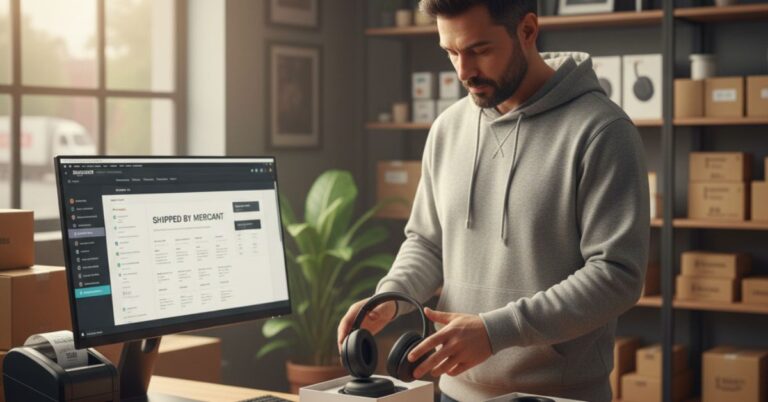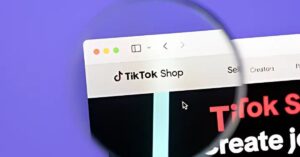
The new Amazon FBM+ Program gives self-fulfilled sellers access to expedited, FBA-like delivery speeds, which helped pilot participants achieve an average 34% sales lift.
When most people talk about selling on Amazon, they think of FBA, Fulfilled by Amazon.
You ship your inventory to Amazon’s warehouses, and they take care of everything else.
But 82% of sellers depending on FBA are feeling the pressure of rising fees, limited control, and unpredictable restock limits.
That’s why the Amazon FBM+ Program is turning heads – it gives sellers the same speed advantage as FBA, without the warehouse costs or constraints.
Amazon FBM+ Program Expands Fulfillment Options for Sellers
Meteor Space"68% of shoppers look for shorter delivery windows at checkout."
News of the program was highlighted on LinkedIn by Vanessa Hung, CEO of Online Seller Solutions. After years of Amazon pushing sellers toward FBA, this new solution expands the self-fulfillment side of the equation.
The program, FBM Ship+, is a new delivery solution for self-fulfilled orders. It allows sellers to offer expedited delivery speeds at no extra cost and shows buyers more accurate delivery promises.
Amazon’s internal pilot study produced significant results. Participating sellers saw an average 34% sales lift once the faster, verified delivery dates were displayed on their listings.
This sales boost came from a large improvement in delivery speed. Packages were delivered an average of nine days faster.
The time saving was driven by two key changes. First, partner carriers shipped 2.5 days faster, and second, Amazon’s new predictive model corrected sellers’ manual estimates by 6.5 days.
The FBM+ Program automates what was previously manual work. Amazon assigns an accurate one-business-day handling time and fast delivery windows based on its partnered expedited carriers.
Sellers must follow a specific process to participate and earn rewards.
- Use Amazon Buy Shipping – Sellers purchase discounted shipping labels directly through Amazon Buy Shipping, available in Seller Central, via API, or through ERP integrations.
- Ship On Time – Sellers must hand packages to partner carriers by the estimated ship date and ensure the package receives an acceptance scan within 48 hours.
- Earn Cash Back – When these steps are met, a cash-back credit is automatically applied to the seller’s account.
Currently, FBM Ship+ is available for shipments from China. Eligible destinations include the U.S., U.K., Germany, Italy, Spain, France, and Japan.
Amazon has confirmed plans to expand the program to more markets and domestic routes. As an early incentive, sellers shipping from China to Europe also qualify for a ¥2 per-order cash back bonus until December 31, 2025.
This program gives self-fulfilled sellers FBA-like precision and buyer confidence. It also allows Amazon to extend its delivery network without expanding its own warehouses.
The move appears to be a strategic decentralization of logistics. Every FBM+ shipment feeds Amazon more data, strengthening its predictive network without Amazon ever touching the seller’s inventory.
How to Use the FBM+ Program
Here are the most important details about the FBM+ program, according to Amazon:
Sellers can enroll in the program from Seller Central. The option is available on the “FBM Ship+” page or under the “Fulfillment Programs” section of the Shipping Settings.
Enrollment involves clicking “Get Started” and then “Enroll to FBM Ship+.” By default, all of a seller’s shipping templates are auto-selected, but this can be changed.
Sellers can add or remove any shipping template they prefer on the “Edit template selection” page. Any changes must be saved to take effect.
How FBM+ Works
The program operates on a three-step process to ensure faster shipping and rewards.
First, Amazon sets accurate and fast delivery dates. The system assigns a maximum one-business-day handling time or a same-day handling time for SKUs that sellers historically ship more quickly.
Second, sellers must buy FBM Ship+ discounted shipping labels through Amazon Buy Shipping. On the Buy Shipping page, sellers can see the discounted carrier rates and the exact cash-back amount they will earn for the shipment.
Third, sellers ship the package and earn cash back. The package must be handed off to the partner carrier by the estimated ship date and receive an acceptance scan within 48 hours.
Once the carrier scans the package, the cash back is added to the seller’s account.
Accessing Labels and Identifying Orders
Sellers have three ways to access Amazon Buy Shipping to purchase the required FBM+ labels:
- In Seller Central – On the “Manage Orders” page, sellers can click “Buy Shipping” for the specific FBM+ order.
- Via Integrators – Sellers can use partnered Multi-Channel Integrators (MCIs) or ERPs. These systems will identify FBM+ orders and allow the purchase of partner carrier labels, such as Yun Express for sellers in China.
- Through APIs – Sellers can use their own software connected to the Orders API and Buy Shipping API. The API will pass an “FBM_SHIP_PLUS” flag or the cash-back amount for the eligible shipping methods.
Sellers can identify FBM+ orders by looking for the “FBM Ship+” badge on the “Manage Orders” page. An “FBM Orders” report can also be downloaded to filter and track these shipments.
Program Limitations
A key detail of the program is that it is only available for items shipped using Standard Shipping.
FBM Ship+ is not currently eligible for other shipping options. This includes Free Economy, Expedite, Premium Shipping, or Seller Fulfilled Prime orders.
YunExpress Partnership Delivers Key Benefits for FBM+ Sellers
YunExpress announced it an official carriers for the new Amazon FBM Ship+ program. This partnership offers a new logistics playbook for sellers shipping from China to key markets like the UK, France, Germany, Italy, Spain, and Japan.
The collaboration is built around three main benefits for a seller’s bottom line.
- Better Cost Management – Sellers get discounted pricing and shipping cashback. This creates meaningful reductions in landed costs and provides ongoing rebate opportunities to protect margins.
- Faster Shipping Speeds – The program offers reduced transit windows. These faster times are designed to improve listing conversion and boost Buy Box performance.
- Seller Metric Protection – The partnership provides robust operational SLAs. This helps minimize late deliveries and safeguards a seller’s account health.
Amazon FBM+ Program Signals a Strategic Shift in Logistics
Robert Principe, founder of eTail Advisors, noted that Amazon has made a clever move. The company found a way to give FBM sellers Prime-like speed while lowering its own risk and overhead.
This new system essentially decentralizes Prime-level shipping. FBM sellers can now act as “micro-FBA nodes” by keeping control of their inventory while competing with FBA on speed and accuracy.
The core of the Ship+ program relies on several key factors.
- Approved Carriers Only – Sellers must use Amazon’s partner carriers through Buy Shipping for reliable tracking and delivery times.
- Faster Shipping – In pilot tests, these carriers shipped orders about 2.5 days quicker than standard FBM.
- Smarter Delivery Promises – Amazon’s predictive model improved delivery estimates by 6.5 days, showing customers faster, more accurate dates.
- Verified Sales Lift – Sellers in the pilot saw a 34% average sales increase just from the better delivery promises.
- Cash-Back Perks – The program also offers sellers credits for each order for using the system and meeting scan deadlines.
This new program is currently limited to shipments from China to the U.S., U.K., Germany, France, Italy, Spain, and Japan. Amazon has already signaled plans to expand into more markets and domestic U.S. routes.
For brands, this shift in fulfillment strategy presents several new opportunities..
- Sellers can compete directly with FBA offers without giving up control of their inventory.
- Brands may save on fulfillment fees while still getting a Prime-like conversion lift.
- The program will offer more flexibility as it expands, especially for domestic fulfillment.
This move gives FBM a new level of power. It may reshape how many brands think about their overall fulfillment strategy.
How FBM+ Fits the Current FBA vs. FBM Dilemma
Our Amazon agency can answer Principe’s question, “Is this something your brand would consider?” The decision to use FBM has always involved complex trade-offs against FBA.
As Amazon’s selling landscape evolves, choosing between Fulfillment by Amazon (FBA) and Fulfillment by Merchant (FBM) has become more difficult. Rising FBA costs and complex inventory rules are causing more sellers to evaluate their options.
FBA offers convenience, with Amazon handling all storage, packing, and shipping. Amazon also accepts accountability for late deliveries, protecting seller ratings.
FBM puts the seller in complete control of customer service, returns, and shipping schedules. This control is often better for specific product types, though it comes with added pressure.
The best fulfillment method often depends on the product itself.
- FBA – This method is preferred for lightweight, small, and fast-selling items, such as kitchen gadgets, that do not incur high storage fees.
- FBM – This method is more economical for bulky, heavy, or custom products, like furniture or personalized items, where FBA fees would be too high.
Sellers can use Amazon’s revenue calculator to see the high cost of FBA for large items, which can include shipping fees over $99 and high referral fees. For small items under one pound, FBA’s $5-6 fee often beats the total FBM cost, which includes labor and packaging.
A common strategy is to use both FBA and FBM for the same product. When a product launch sells out of FBA inventory, a seller can use FBM to prevent sales loss.
To do this, sellers create a duplicate SKU linked to the same ASIN, a policy-compliant tactic. This allows them to add inventory to an FBM offer and ship from a local warehouse while waiting for FBA centers to restock.
"FBM is still a strong option on Amazon - while FBA is popular, new products can take weeks to check in. Keeping two SKUs, one for FBA and one for FBM (I add a '-FBM' suffix), lets you fulfill orders seamlessly even if FBA delays."





